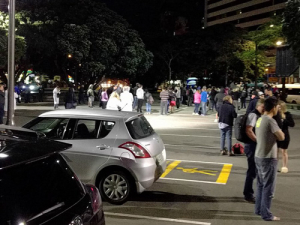Post-quake study reveals hort potential
Large areas of North Canterbury and South Marlborough – affected by the 2016 Kaikoura Earthquakes – offer wide potential for horticulture.
 Worried people in Wellington fill a downtown carpark after the quake on early Monday morning. Photo: @nkpnz on Twitter.
Worried people in Wellington fill a downtown carpark after the quake on early Monday morning. Photo: @nkpnz on Twitter.
I have lived in and around Wellington all my life and I have never experienced an earthquake as big and as frightening as this latest one.
But interestingly some things haven’t changed. Once again the windows fell out of the old Dominion Farmers building on the corner of Featherston and Balance St, just opposite where HortNZ is now based. I can recall windows from that building dropping out one Saturday night 40 years ago when I was working at TV-1 when the studios were based in nearby Waring Taylor St. In those days that building housed MAF’s head office. Every time there is an earthquake the windows go and it’s a miracle that over the years no one has been killed or injured
Further down Featherston St the building where Federated Farmers used to be based, Agriculture House, a similar thing happened 40 years ago and it happened again this week.
MPI’s ‘new’ building has also been out of action for the last two days as have Beef+Lamb NZ and Feds. The latter two are now back in operation.
On the waterfront the ‘new’ Greater Wellington Regional Council (GWRC) offices are uninhabitable because of quake damage. They moved there a few years ago when their other building was damaged in 2013 and declared an earthquake risk. It seems the GWRC aren’t great at picking safe buildings.
This quake serves to point out the vulnerability of Wellington. It has been damaged in recent years by the Seddon and now the Kaikoura quake but it has yet to suffer the so called ‘big-one’. And let’s not forget the floods that added to everyone’s woes this week. Many agri related organisations are located in high rise buildings in the capital and this latest quake is a reminder, if ever one was needed, about the need to have good back-up and contingency plans.
This latest quake showed how a small town like Kaikoura can become quickly isolated. Wellington is similarly vulnerable only on larger scale.
According to the latest Federated Farmers banking survey, farmers are more satisfied with their bank and less under pressure, however, the sector is well short of confidence levels seen last decade.
Farmer confidence has taken a slight dip according to the final Rabobank rural confidence survey for the year.
Former Agriculture Minister and Otaki farmer Nathan Guy has been appointed New Zealand’s Special Agricultural Trade Envoy (SATE).
Alliance Group has commissioned a new heat pump system at its Mataura processing plant in Southland.
Fonterra has slashed another 50c off its milk price forecast as global milk flows shows no sign of easing.
Meat processors are hopeful that the additional 15% tariff on lamb exports to the US will also come off.

OPINION: The release of the Natural Environment Bill and Planning Bill to replace the Resource Management Act is a red-letter day…
OPINION: Federated Farmers has launched a new campaign, swapping ‘The Twelve Days of Christmas’ for ‘The Twelve Pests of Christmas’ to…